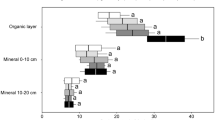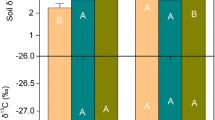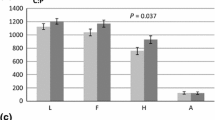Abstract
Experimental findings indicate that, in terrestrial ecosystems, nitrogen cycling changes under elevated partial pressure of atmospheric CO2 (pCO2). It was suggested that the concentration of N in plant litter as well as the amount of litter are responsible for these changes. However, for grassland ecosystems, there have been no relevant data available to support this hypothesis. Data from five years of the Swiss FACE experiment show that, under fertile soil conditions in a binary plant community consisting of Lolium perenne L. and Trifolium repens L., the concentration of litter N does not change under elevated atmospheric pCO2; this applies to harvest losses, stubble, stolons and roots as the sources of litter. This is in strong contrast to the CO2 response of L. perenne swards without associated legumes; in this case the above-ground concentration of biomass N decreased substantially. Increased symbiotic N2 fixation in T. repens nodules and a greater proportion of the N-rich T. repens in the community are regarded as the main mechanisms that buffer the increased C introduction into the ecosystem under elevated atmospheric pCO2. Our data also suggest that elevated atmospheric pCO2 results in greater amounts of litter, mainly due to increased root biomass production. This study indicates that, in a fertile grassland ecosystem with legumes, the concentration of N in plant litter is not affected by elevated atmospheric pCO2 and, thus, cannot explain CO2-induced changes in the cycling of N.
Similar content being viewed by others
References
Blum H, Hendrey G R and Nösberger J 1997 Effects of elevated CO2, N fertilization, and cutting regime on the production and quality of Lolium perenne L. shoot necromass. Acta Oecol. 18, 291–295.
Casella E and Soussana J-F 1997 Long-term effect of CO2 enrichment and temperature increase on the carbon balance of temperate grass sward. J. Exp. Bot. 48, 1309–1321.
Cotrufo M F, Ineson P and Scott A 1998 Elevated CO2 reduces the nitrogen concentration of plant tissues. Global Change Biol. 4, 43–54.
Diaz S, Grime J P, Harris J and McPherson E 1993 Evidence of a feedback mechanism limiting plant response to elevated carbon dioxide. Nature 364, 616–617.
Fischer B U, Frehner M, Hebeisen T, Zanetti S, Lüscher A, Hartwig U A, Hendrey G R, Blum H and Nösberger J 1997 Source-sink relations in Lolium perenne L. as reflected by carbohydrate concentrations in leaves and pseudo-stems during regrowth in a free air carbon dioxide enrichment (FACE) experiment. Plant Cell Environ. 20, 945–952.
Fitter A H, Graves J D, Wolfenden J, Self G K, Brown T K, Bogie D and Mansfield T A 1997 Root production and turnover and carbon budgets of two contrasting grasslands under ambient and elevated atmospheric carbon dioxide concentrations. New Phytol. 137, 247–255.
Frehner M, Lüscher A, Hebeisen T, Zanetti S, Schubiger F and Scalet M 1997 Effec of elevated partial pressure of carbon dioxide and season of the year on forage quality and cyanide concentration of Trifolium repens from a FACE experiment. Acta Oecol. 18, 297–304.
Garwood E A 1967 Seasonal variation in appearance and growth of grass roots. J. British Grassland Soc. 22, 121–130.
Gifford R M 1994 The global carbon cycle: a viewpoint on the missing link. Aust. J. Plant Physiol. 21, 1–15.
Gregorich E G, Carter M R, Angers D A, Monreal C M and Ellert B H 1994 Towards a minimum data set to assess soil organic matter quality in agricultural soils. Can. J. Soil Sci. 74, 367–385.
Gregory P J, Palta J A and Batts G R 1996 Root systems and root:mass ratio - carbon allocation under current and projected atmospheric conditions in arable crops. Plant Soil 187, 221–228.
Hartwig U A 1998 The regulation of symbiotic N2 fixation: a conceptual model of N feedback from the ecosystem to the gene expression level. Perspectives in Plant Ecology, Evolution and Systematics 1, 92–120.
Hartwig U A, Zanetti S, Hebeisen T, Lüscher A, Frehner M, Fischer B U, van Kessel C, Hendrey G R, Blum H and Nösberger J 1996 Symbiotic nitrogen fixation: one key to understand the response of temperate grassland-ecosystems to elevated CO2? In Carbon Dioxide, Populations, and Communities. Eds C Körner and F A Bazzaz pp 253–264. Academic Press, San Diego, CA.
Hebeisen T, Lüscher A, Zanetti S, Fischer B U, Hartwig U A, Frehner M, Hendrey G R, Blum H and Nösberger J 1997 Growth response of Trifolium repens L. and Lolium perenne L. as monocultures and binary mixture to free air CO2 enrichment and management. Global Change Biol. 3, 149–160.
Ineson P, Cotrufo M F, Bol H, Harkness D D and Blum H 1996 Quantification of soil carbon inputs under elevated carbon dioxide: C3 plants in C4 soil. Plant Soil 187, 345–350.
Ineson P, Coward P A and Hartwig U A 1998 Soil trace gas fluxes of N2O, CH4 and CO2 beneath Lolium perenne under elevated CO2: the Swiss free air carbon dioxide enrichment experiment. Plant Soil 198, 89–95.
Jones T H, Thompson L J, Lawton J H, Bezemer T M, Bardgett R D, Blackburn T M, Bruce K D, Cannon P F, Hall G S, Hartley S E, Howson G, Jones C G, Kampichler C, Kandeler E and Ritchie D A 1998 Impact of rising atmospheric carbon dioxide on model terrestrial ecosystems. Science 280, 441–443.
Jongen M, Jones M B, Hebeisen T, Blum H and Hendrey G R 1995 The effects of elevated CO2 concentrations on the root growth of Lolium perenne and Trifolium repens grown in a FACE system. Global Change Biol. 1, 361–371.
Lewin K F, Hendrey G R, Nagy J and Lamorte R L 1994 Design and application of a free-air carbon dioxide enrichment facility. Agric. For. Meteorol. 70, 15–29.
Loiseau P and Soussana J-F 1999a. Elevated CO2, temperature increase and N supply effects on the accumulation of belowground carbon in a temperate grassland ecosystem. Plant Soil. 212, 123–134.
Loiseau P and Soussana J-F 1999b. Elevated CO2, temperature increase and N supply effects on the turnover of below-ground carbon in a temperate grassland ecosystem. Plant Soil. 210, 233–247.
Lüscher A, Hebeisen T, Zanetti S, Hartwig U A, Blum H, Hendrey G R and Nösberger J 1996 Differences between legumes and nonlegumes of permanent grassland in their responses to freeair carbon dioxide enrichment: its effect on competition in a multispecies mixture. In Carbon Dioxide, Populations, and Communities. Eds C Körner and F A Bazzaz pp 287–300. Academic Press, San Diego, CA.
Lüscher A, Hendrey G R and Nösberger J 1998 Long-term responsiveness to free air CO2 enrichment of functional types, species and genotypes of permanent grassland. Oecologia 113, 37–45.
Marschner H 1995 Mineral nutrition of higher plants. Academic Press, London, 889 p.
Marilley L, Hartwig U A and Aragno M 1999 Influence of an elevated atmospheric CO2 content on soil and rhizosphere bacterial communities beneath Lolium perenne and Trifolium repens under field conditions. Microb. Ecol. (In press).
Mellilo J M, Aber J D, Linkins A E, Ricca A, Fry B and Nadelhoffer K J 1989 Carbon and nitrogen dynamics along the decay continuum: plant litter to soil organic matter. Plant Soil 115, 189–198.
Nitschelm J J, Lüscher A, Hartwig U A and van Kessel C 1997 Using stable isotopes to determine soil carbon input differences under ambient and elevated atmospheric CO2 conditions. Global Change Biol. 3, 411–416.
Rogers A, Fischer B U, Bryant J, Frehner M, Blum H, Raines C A and Long S P 1998 Acclimation of photosynthesis to elevated CO2 under low-nitrogen nutrition is affected by the capacity for assimilate utilization. Perennial ryegrass under Free-Air CO2 Enrichment. Plant Physiol. 118, 683–689.
Rogers H H, Prior S A, Runion G B and Mitchell R J 1996 Root to shoot ratio of crops as influenced by CO2. Plant Soil 187, 229–248.
Schapendonk A H C M, Dijkstra P, Groenwold J, Pot C S and van de Geijn S C 1997 Carbon balance and water use efficiency of frequently cut Lolium perenne L. swards at elevated carbon dioxide. Global Change Biol. 3, 207–216.
Schortemeyer M, Hartwig U A, Hendrey G R and Sadowsky M J 1996 Microbial community changes in the rhizospheres of white clover and perennial ryegrass exposed to free air carbon dioxide enrichment (FACE). Soil Biol. Biochem. 28, 1717–1724.
Soussana J-F and Hartwig U A 1996 The effect of elevated CO2 on symbiotic N2 fixation: a link between the carbon and nitrogen cycles. Plant Soil 187, 321–332.
Soussana J-F, Casella E and Loiseau P 1996 Long-term effects of CO2 enrichment and temperature increase on a temperate grass sward. II. Plant nitrogen budgets and root fraction. Plant Soil 182, 101–114.
Thornley J HM1998 Grassland dynamics: an ecosystem simulation model. CAB International, Wallingford, Oxon. 241 p.
Thornley J H M and Cannell M G R 1999 Dynamics of mineral N availability in ecosystems under increased CO2: hypothesis developed using the Hurley Pasture Model. Plant Soil. 224, 153–170.
Troughton A 1981 Length of life of grass roots. Grass Forage Sci. 36, 117–120.
Zanetti S and Hartwig U A 1997 Symbiotic N2 fixation increases under elevated atmospheric pCO2 in the field. Acta Oecol. 18, 285–290.
Zanetti S, Hartwig U A, Lüscher A, Hebeisen T, Frehner M, Fischer B U, Hendrey G R, Blum H and Nösberger J 1996 Stimulation of symbiotic N2 fixation in Trifolium repens L. under elevated atmospheric CO2 in a grassland ecosystem. Plant Physiol. 112, 575–583.
Zanetti S, Hartwig U A, van Kessel C, Lüscher A, Hebeisen T, Frehner M, Fischer B U, Hendrey G R, Blum H and Nösberger J 1997 Does N nutrition restrict the CO2 response of fertile grasslands lacking legumes? Oecologia 112, 17–25.
Zanetti S, Hartwig U A and Nösberger J 1998 Elevated atmospheric CO2 does not affect per se the preference for symbiotic nitrogen as opposed to mineral nitrogen of Trifolium repens L. Plant Cell Environ. 21, 623–630.
Rights and permissions
About this article
Cite this article
Hartwig, U.A., Lüscher, A., Daepp, M. et al. Due to symbiotic N2 fixation, five years of elevated atmospheric pCO2 had no effect on the N concentration of plant litter in fertile, mixed grassland. Plant and Soil 224, 43–50 (2000). https://doi.org/10.1023/A:1004601915836
Issue Date:
DOI: https://doi.org/10.1023/A:1004601915836




